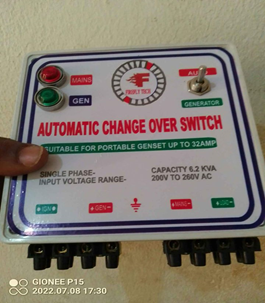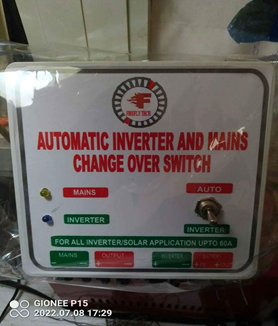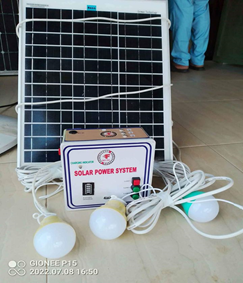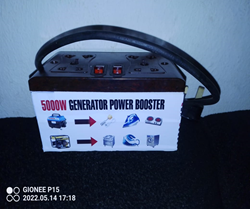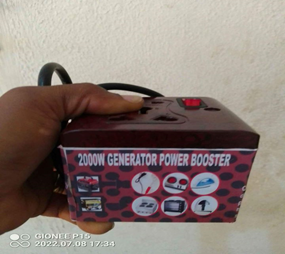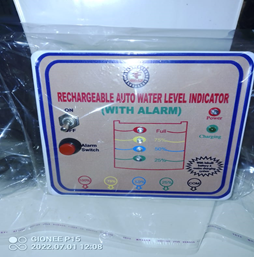ENVIROMENTAL IMPACT OF LEACHATE POLLUTION OF GROUND WATER
USER'S INSTRUCTIONS: The project work you are about to view is on "enviromental impact of leachate pollution of ground water". Please, sit back and study the below research material carefully. This project topic (enviromental impact of leachate pollution of ground water) have complete 5(five) Chapters. The complete Project Material/writeup include: Abstract + Introduction + etc + Literature Review + methodology + etc + Conclusion + Recommendation + References/Bibliography.Our aim of providing this "enviromental impact of leachate pollution of ground water" project research material is to reduce the stress of moving from one school library to another all in the name of searching for "enviromental impact of leachate pollution of ground water" research materials. We are not encouraging any form of plagiarism. This service is legal because, all institutions permit their students to read previous projects, books, articles or papers while developing their own works.
TITLE PAGE
BY
---
--/H2013/01430
DEPARTMENT OF ----
SCHOOL OF ---
INSTITUTE OF ---
DECEMBER,2018
APPROVAL PAGE
This is to certify that the research work, "enviromental impact of leachate pollution of ground water" by ---, Reg. No. --/H2007/01430 submitted in partial fulfillment of the requirement award of a Higher National Diploma on --- has been approved.
By
--- . ---
Supervisor Head of Department.
Signature………………. Signature……………….
……………………………….
---
External Invigilator
DEDICATION
This project is dedicated to Almighty God for his protection, kindness, strength over my life throughout the period and also to my --- for his financial support and moral care towards me.Also to my mentor --- for her academic advice she often gives to me. May Almighty God shield them from the peril of this world and bless their entire endeavour Amen.
ACKNOWLEDGEMENT
The successful completion of this project work could not have been a reality without the encouragement of my --- and other people. My immensely appreciation goes to my humble and able supervisor mr. --- for his kindness in supervising this project.
My warmest gratitude goes to my parents for their moral, spiritual and financial support throughout my study in this institution.
My appreciation goes to some of my lecturers among whom are Mr. ---, and Dr. ---. I also recognize the support of some of the staff of --- among whom are: The General Manager, Deputy General manager, the internal Auditor Mr. --- and the ---. Finally, my appreciation goes to my elder sister ---, my lovely friends mercy ---, ---, --- and many others who were quite helpful.
PROJECT DESCRIPTION: This work "enviromental impact of leachate pollution of ground water" research material is a complete and well researched project material strictly for academic purposes, which has been approved by different Lecturers from different higher institutions. We made Preliminary pages, Abstract and Chapter one of ""enviromental impact of leachate pollution of ground water visible for everyone, then the complete material on "enviromental impact of leachate pollution of ground water" is to be ordered for. Happy viewing!!!
Groundwater pollution is mainly due to the process of industrialization and urbanization that has progressively developed over time without any regard for environmental consequences. Its quality is based on the physical and chemical soluble parameters due to weathering from source rocks and anthropogenic activities. In recent times, the impact of leachate on groundwater and other water resources has attracted a lot of attention because of its overwhelming environmental significance. Leachate migration from wastes sites or landfills and the release of pollutants from sediments (under certain conditions) pose a high risk to groundwater resource if not adequately managed.
Protection of groundwater is a major environmental issue since the importance of water quality on human health has attracted a great deal of interest lately. Assessing groundwater quality and developing strategies to protect aquifers from contamination are necessary for proper planning and designing water resources. Open dumps are the oldest and most common way of disposing of solid wastes, although in recent years, thousands have been closed, many are still being used. Because of these, waste management has become increasingly complex due to the increase in human population, industrial and technological revolutions and the processes that control the fate of wastes in the soil is complex and many of them are poorly understood. Issues such as nutrients release rate and other chemicals, leaching of nutrients, metals through macro pores as suspended solids and sludge organic matter on the degradation are often not understood by many.
Leaching of hydrophobic organics and fate of metals fixed by soil organic matter needed to be studied to have a better approach in handling groundwater pollution. Toxic chemicals that have high concentration of nitrate and phosphate derived from waste in the soil can filter through a dump and contaminate both ground and surface water. Insects, rodents, snakes and scavenger birds, dust, bad odour are some of the Aesthetic problems associated with sanitary landfill.
TABLE OF CONTENT
COVER PAGE
APPROVAL PAGE
DEDICATION
ACKNOWLEDGEMENT
TABLE OF CONTENT
-
INTRODUCTION
- BACKGROUND OF THE STUDY
- STATEMENT OF THE RESEARCH PROBLEM
- PURPOSE OF THE STUDY
- AIM AND OBJECTIVES OF THE STUDY
- SCOPE OF THE STUDY
- SIGNIFICANCE OF THE STUDY
- LIMITATION
- DEFINITION OF TERMS
CHAPTER TWO
2.0 LITERATURE REVIEW
2.1 CONCEPTUAL FRAMEWORK
2.2 CONCEPT OF WASTE
2.3 RESEARCH GAP
CHAPTER THREE
METHODOLOGY
3.0 TYPES AND SOURCES OF DATA REQUIRED
3.1 SAMPLING TECHNIQUE
3.2 METHODUSED FOR PHYSICAL ANALYSIS
3.3 DATA ANALYSIS
CHAPTER FOUR
4.0 PHYSICO-CHEMICAL PROPERTIES OF WELL WATER IN THE STUDY AREA
4.1 PHYSICO-CHEMICAL PROPERTIES OF WELL WATER
4.2 HEAVY METALS CONCENTRATION IN WELL WATER SAMPLE
CHAPTER FIVE
5.0 CONCLUSION AND RECOMMENDATIONS
5.1 CONCLUSION
5.2 RECOMMENDATIONS
- INTRODUCTION
Waste is defined as unwanted or undesired materials accumulating after the completion of a process (Cointreau, 2001). Waste is also characterized as items that are no longer used for any significant function. They are classified as items with hazardous properties. Such hazardous wastes include household dump items, sewage, sludge, waste from manufacturing industries etc. (Obeka, 2005).
Adekunle, et al., (2007) assessed the levels of some physical, chemical, biochemical and microbial water quality parameters in twelve hand-dug wells in Igbara area of South West region of Nigeria. From the results of analysis, it was discovered that most of the pollutants increased in concentration during the rainy season over dry periods. Coliform population, lead, nitrate and cadmium in most cases, exceeded the World Health Organization (WHO) recommended thresholds for potable water. It was therefore concluded that well water in the area is not safe for direct consumption. Regular monitoring of groundwater quality, abolishment of unhealthy waste disposal practices and introduction of modern techniques were recommended.
Longe and Balogun (2010) investigated the extent of groundwater contamination of six sampling points between 10 and 375 meters down-gradient of a landfill site.
From results of the analysis, it was discovered that the groundwater samples were generally acidic with a mean pH value of 6.13 which is below the World Health Organization WHO and Nigeria Standard for Drinking Water Quality (NSDWQ) guidelines for portable water, the study revealed that the quantity of the groundwater resource underlying soils landfill site has been moderately impacted.
It was also shown that nitrate, chromium and phosphate concentrations were above the highest permissible limits (WHO, 2004 NSDWQ, 2007). Observations revealed that with time, the accumulation of leachate at the base of the sanitary landfill can break through into the groundwater while gas emission also posed potential environmental and health risk. Yaya and Okafor (2010) also analysed the microbial status of groundwater and surface water in the Federal Capital City of Nigeria (Abuja), taking samples during the dry and rainy seasons. Result of the research revealed that coliform count in most of the water samples from borehole (deep well) satisfy the permissible level prescribed for drinking water in the two seasons in line with WHO and NSDWQ. This was not so for samples from rivers and streams in the same area.
1.1 BACKGROUND OF THE STUDY
Waste is defined as unwanted or undesired materials accumulating after the completion of a process (Cointreau, 2001). Waste is also characterized as items that are no longer used for any significant function. They are classified as items with hazardous properties. Such hazardous wastes include household dump items, sewage, sludge, waste from manufacturing industries etc. (Obeka, 2005).
The United Nations Environmental Programme (UNEP) Yearbook (2006) defines waste as those materials for which the initial user has no further use, either for purposes of production, transformation or consumption and can therefore be disposed of.
Adebibu (1985) grouped solid wastes into eight classes, namely domestic, municipal, industrial, agricultural, pesticides, residential and hazardous wastes. However, solid waste can be classified as biodegradable, or non-biodegradable, soluble or insoluble, organic or inorganic, toxic or non-toxic (Kostawa, 2006; Ajadike, 2007). Irrespective of the classification of solid wastes, most of the urban wastes are degradable which aids the rate of leachate formation and migration compared to non-biodegradable that can last for many years without any sign of decomposition. There is therefore a possibility of leachate generation; plume extension and migration at the base of urban land fill owing to the decomposition of discarded materials and frequent surface water ingression from urban precipitation.
Because of the inability to sort waste at source, household waste and industrial wastes including toxic waste are often handled together leading to soil and underground water pollution (Osibanjo, 2008).
Supply of adequate fresh water in large quantity to meet man’s demand and maintaining the quality is therefore a thing of concern (Elinge, Itodo, Birn, Yauri and Mobongo, 2011). Hence contamination of groundwater through the infiltration of leachates via the soil and rocks needs to be avoided.
1.2 STATEMENT OF THE PROBLEM
The problem of this study is to determine the environmental impact of leachate pollution of ground water supplies in Olukori, Ila-Orangun, Osun state
1.3 PURPOSE OF THE STUDY
The purpose of the study is to know to what extent, increase in waste generation and disposal resulted in the increase of groundwater pollution, and how it has affected the well water in Olukori area of Ila-Orangun.
1.4 AIMS AND OBJECTIVES OF THE STUDY
i. To know the physical properties and chemical properties of the water samples in the area
ii. To determine the effect of landfill leachate in groundwater and its effect on human health
1.5 SIGNIFICANCE OF THE STUDY
Leachate migration from waste sites or landfills and the release of pollutants from sediments (under rain conditions) pose a high risk to groundwater resource, and also to human if not adequately managed.
1.6 SCOPE OF THE STUDY
This research work covers landfill leachate and how it affects groundwater supply in Olukori area.
1.7 LIMITATION OF THE STUDY
i. Financial constraints
ii. The study is limited to landfill leachate in Olukori area, Ila-Orangun
ii. Time constraints
iii. Lack of mobility to the area.
1.8 DEFINITION OF TERMS
GROUNDWATER: This is the water located beneath the surface of the earth’s surface in soil pore spaces and in the fractures of rock formations.
LANDFILL: This is a site for the disposal of waste materials by burial, the oldest form of waste disposal.
QUALITY: This refers to an attribute or a property of something
POLLUTION: This is the introduction of contaminants into the natural environment that causes adverse change.
LEACHATE: this is any liquid that in passing through matter, extracts solutes, suspended solids or any other components of the materials through which it has been passed.
CHAPTER TWO: The chapter one of this work has been displayed above. The complete chapter two of "enviromental impact of leachate pollution of ground water" is also available. Order full work to download. Chapter two of "enviromental impact of leachate pollution of ground water" consists of the literature review. In this chapter all the related works on ""enviromental impact of leachate pollution of ground water were reviewed.
CHAPTER THREE: The complete chapter three of ""enviromental impact of leachate pollution of ground water is available. Order full work to download. Chapter three of "enviromental impact of leachate pollution of ground water" consists of the methodology. In this chapter all the method used in carrying out this work was discussed.
CHAPTER FOUR: The complete chapter four of ""enviromental impact of leachate pollution of ground water is available. Order full work to download. Chapter four of ""enviromental impact of leachate pollution of ground water consists of all the test conducted during the work and the result gotten after the whole work
CHAPTER FIVE: The complete chapter five of design and construction of a "enviromental impact of leachate pollution of ground water" is available. Order full work to download. Chapter five of "enviromental impact of leachate pollution of ground water" consist of conclusion, recommendation and references.
To "DOWNLOAD" the complete material on this particular topic above click "HERE"
Do you want our Bank Accounts? please click HERE
To view other related topics click HERE
To "SUMMIT" new topic(s), develop a new topic OR you did not see your topic on our site but want to confirm the availiability of your topic click HERE
Do you want us to research your new topic? if yes, click "HERE"
Do you have any question concerning our post/services? click HERE for answers to your questions
For more information contact us through any of the following means:
Mobile No ![]() :+2348146561114 or +2347015391124 [Mr. Innocent]
:+2348146561114 or +2347015391124 [Mr. Innocent]
Email address ![]() :engr4project@gmail.com
:engr4project@gmail.com
Visit the link below to see our recent works, and SUBSCRIBE to receive notification for our electronics teachings and practicals.
https://www.youtube.com/channel/UChY9Z1-egigJbYjYnapd0nw
COUNTRIES THAT FOUND OUR SERVICES USEFUL
Australia, Botswana, Canada, Europe, Ghana, Ireland, India, Kenya, Liberia, Malaysia, Namibia, New Zealand, Nigeria, Pakistan, Philippines, Singapore, Sierra Leone, South Africa, Uganda, United States, United Kindom, Zambia, Zimbabwe, etc
Support: +234 8146561114 or +2347015391124
Watsapp No :+2348146561114
:+2348146561114
Email Address  :engr4project@gmail.com
:engr4project@gmail.com
FOLLOW / VISIT US VIA:




